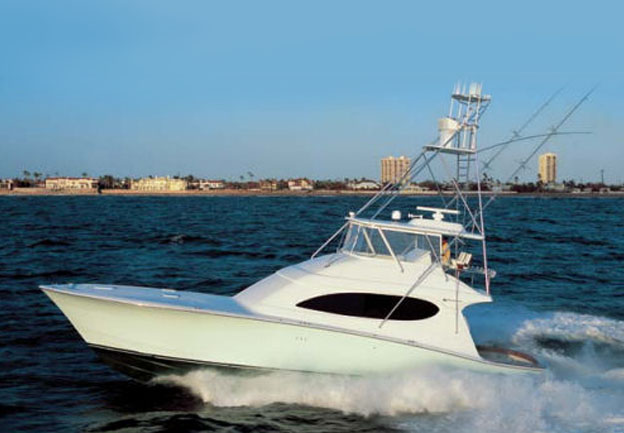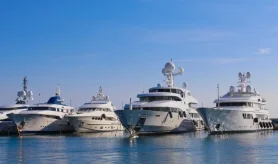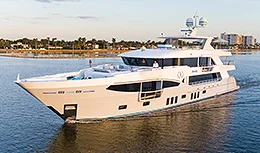- Alaskan Yachts
- Azimut Yachts
- Back Cove Yachts
- Beneteau Yachts
- Benetti Superyachts
- Bertram Yachts
- Boston Whaler
- Broward Yachts
- Buddy Davis Sportfish
- Burger Yachts
- Cabo Yachts
- Catamarans
- Carver Motoryachts
- Center Console
- Chris-Craft Yachts
- Cruisers Yachts
- DeFever Trawlers
- Dufour Sailboats
- Fairline Yachts
- Feadship Yachts
- Ferretti Yachts
- Filippetti Yachts
- Formula Yachts
- Fountaine Pajot Cats
- Grady-White
- Grand Banks Trawlers
- Hargrave Yachts
- Hatteras Yachts
- Hinckley Picnic Boats
- Horizon Yachts
- Hydra-Sports
- Intrepid Boats
- Jarrett Bay Sportfish
- Jeanneau Yachts
- Kadey-Krogen Trawlers
- Lazzara Yachts
- Lekker Boats
- Luhrs Sportfish
- Marlow Yachts
- Maritimo Yachts
- Marquis Yachts
- Mazu Yachts
- McKinna Motoryachts
- Meridian Yachts
- Midnight Express
- MJM Yachts
- Mochi Craft
- Neptunus Motoryachts
- Nordhavn Trawlers
- Nordic Tugs
- Numarine Yachts
- Ocean Alexander Yachts
- Ocean King
- Offshore Yachts
- Outer Reef
- Oyster Sailing Yachts
- Pacific Mariner Yachts
- Palmer Johnson Yachts
64 Hatteras Convertible 2010
![]()

Source: Power & Motoryacht Magazine
It is almost as if the Hatteras designers looked at the best convertibles on the market in the 64’ range and decided to one-up the leading competitors on the market in all of the important parameters. The Hatteras 64 C is longer, beamier, has the shallowest draft, the most displacement, and carries more fuel than her prime competitors. She makes good use of her 19’ 6” beam (6 m) to be able to handle big diesels in her belly, and provide a larger saloon and a bigger flying bridge above. She has the distinction of being the only convertible in the mid-60-foot range to have a full beam master stateroom, something you usually only see on motor yachts. As convertibles are used more and more for cruising, particularly in Europe and in Latin America, cruising comfort, amenities and practicality are playing a larger role in the decision-making process.
The Mission
The mission of a 64’ convertible is to take a gang of people out in blue water and hunt for big game. That may mean that the boat will be campaigned on a gold-plated billfish tournament schedule down the East Coast of the U.S., going as far away as the Caribbean, Venezuela, Costa Rica and Cozumel. On the West Coast that may mean cruising down to Cabo San Lucas from Southern California, or maybe going as far south as Panama or Peru. European anglers will want to get out into the middle of the Med, and Australians will want a boat that can comfortably take them from Sydney up to Lizard Island.
All of these destinations require a seaworthy boat that is comfortable. So while the ultimate goal is to tangle with world record billfish and be able to successfully bring them to wire, there is a lot more to the mission of one of these battlewagons than outriggers and frozen bait. The boat must get the anglers to and from the action with reliability and with as little punishment as possible.
The Cockpit
There are several key parameters to a big game cockpit, and the Hatteras 64 C is on the money with every one. First, the fore and aft dimension must be long enough for the fighting chair, with room behind for a mate to guide the chair, as well as room in front for the mate to pass from side to side. Second, the gunwale needs to be low enough that the mate can easily grab the wire, gaff the prey and bring the fish into the cockpit if that is the intention. Yet, the transom must be high enough that the boat can be quickly backed down if need be without flooding the cockpit. And if the cockpit does take green water over the transom in rough conditions, then the scuppers must be large enough to quickly drain, and the stern must be buoyant enough to withstand the added weight of several hundred gallons of water.
Hatteras is an old hand at building offshore fishing boats and all of that experience has gone into the design of the 64 C. The mezzanine seating arrangement is about the only new thing that has hit convertible cockpit design over the last 20 years and underneath it Hatteras will put pretty much anything you want there. Just ask.
Unique Features
It is hard to find unique features in the convertibles built by the top three or four builders. The reason is that they are all trying to build a good, state-of-the-art boat and when one discovers a good idea the others quickly follow. All are seasoned boat builders and none of the top builders are cutting corners. So what is unique? We have already tipped you off: the added beam and the full-beam master stateroom (166 sq. ft./15.7 sq. m). But there is more—
That beam pays dividends in a lot of other areas, too. It allows all of the staterooms and heads to be larger. Because of it, the settee opposite the galley has more room. And on the flying bridge there is 186 sq. ft. (17.6 sq. m) of space. The standard FB layout is a traditional one that Hatteras has used for years and is very hard to beat. It is, in fact, a great place to have a cocktail party, seat a race committee, or for a couple of tired, sun-baked anglers, to take an afternoon siesta.
Hatteras also offers an enclosed flying bridge version.
Beam Pays More Dividends
The boat’s beam along with the fact that the engine room air intakes are under the gunwales in the forward part of the cockpit, means there is a lot more room outside of the engines in the engine room. The absence of air-intake baffles or Delta-T demisters on the hull sides creates added space in a critical area. This makes it easy to get outboard of the engines to check hoses, hose clamps and other gear. When running, two powerful fans in the aft quarters of the engine room pump air into the maw of the standard C-32 Cat 1800-hp engines. At rest or idle, one fan blows in and the other sucks hot air out.
Added beam also means added stability and more initial resistance to rolling. This is probably most noticeable at anchor or even at the outside dock where a 64’ boat will be much of the time. Mama will like that.
The Hatteras 64 is the heaviest of the major boats in class, but she draws the least, at 4’10” (1.43 m). A big part of the reason for that is because of her added beam, allowing her footprint to be wider and therefore not as deep in the water.
Construction Differences
There are two major differences in construction between Hatteras and most other builders. First, Hatteras does not use balsa core below the waterline, nor does it use any other coring material there. Below the waterline, the Hatteras 64 hull is 100% fiberglass. Hatteras does this so there is no question of osmotic water migration and to reduce chances of delaminating due to a defect in materials or sandwich construction.
Second, Hatteras is one of the few production builders that paints its hull rather than having a gelcoat surface. Even the highest quality gelcoat oxidizes. That is why you see the crews of megayachts compounding their hulls three or four times a year. Further, from time to time even the best builders can get a bad batch of gelcoat from the manufacturer and have problems such as crazing or cracking.
Hatteras does use gelcoat, in fact it uses two coats of it, one white and one black for opacity. But then the company paints the whole surface of the boat above the waterline with polyurethane paint. The resulting surface has a bright, shinny luster that lasts for 10 years or so. Hatteras hulls need very little maintenance and their polyurethane paint surface is one of the reasons that even old Hatteras yachts look like a million bucks.
Third, because of Hatteras’ North Carolina heritage the bow has a lot of flair, and more than most of its close competitors. The flair throws water to the sides and down when the seas get rough, helping to create a dryer ride.
UL- Approved Fuel Tanks
Fourth, Hatteras is the only boat builder that we know of that installs UL-approved fiberglass fuel tanks. What does that mean? It means that the materials used are able to resist fire for a certain number of minutes without degrading. They are also pressure tested. All of this means that the tanks are strong, are built as well or better than any in the industry, and are unlikely to split or have other problems. Further, Hatteras fuel tanks have baffles every 17” which reduces the free surface effect that can contribute to capsizing in unusually tempestuous conditions.
Fiberglass fuel tanks are not easy to manufacturer and many builders of large motoryachts do not install them for that reason. Rather, these builders install aluminum tanks which are susceptible to corrosion and are hard to put in the lowest part of the boat to add stability. The Hatteras fuel tanks are glassed into the bottom of the hull, which keeps the CG low and effectively creates a double bottom for the boat in these areas.
Finally, Hatteras Yachts was born in High Point, NC – the epicenter of furniture making in the U.S. The company started in an area where fine joiner work was second-nature to generations of local craftsmen and from the beginning Hatteras set the bar high for American boat builders when it came to interior fit and finish. The company is no longer building boats in High Point because its models are now too big to be transported 175 miles to navigable water. Nevertheless, its tradition of fine carpentry has been maintained in New Bern.
Accommodation Plans
We can’t think of a production builder that offers more accommodation plans in class than does Hatteras in its 64 convertible. The company publishes three different plans including a 4 stateroom/3 head version and a 3 stateroom/3 head plan. It will put a queen berth or twins in two of its three guest staterooms, or mix and match to please. Note the size of these staterooms and the distance between the twin beds, particularly in the port side cabin. This is where the added beam of the boat pays off again.
The fourth cabin can be an office, utility room, or storage room, instead of having two bunks. The folks at Hatteras tell us that they aim to please, so if a customer has a different idea, they are all ears.
Boat Specifications: 64 Hatteras Convertible 2010
Length Overall 63′ 10”19.46 m
Dry Weight 115,00053,163 kg
Beam 19′ 6”5.94 m
Fuel Cap 1,950 gal.7,379 L
Draft 4′ 10”1.47 m
Water Cap 343 gal.1,298 L
Deadrise/Transom N/A
Bridge Clearance N/A
Max Headroom N/A



